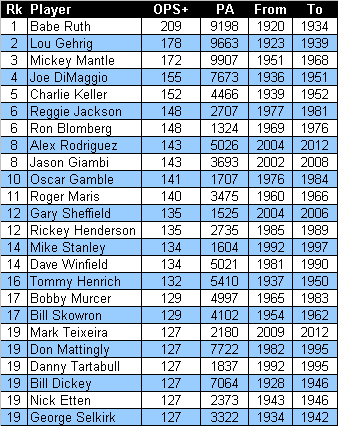(The following was originally published at SB*Nation’s Pinstripe Alley)
Bill “Moose” Skowron didn’t have the boyish charm or matinee idol looks of Mickey Mantle. Instead, he portrayed a gruff exterior and chiseled profile that was more befitting a football player, which was appropriate, considering the Yankees signed him off the college gridiron. Beneath the surface, however, those who knew him best described Skowron as a gentle giant. To everyone else, he was one of the faces of the great Yankees dynasty under Casey Stengel as well as an enduring crowd favorite on Old Timer’s Day and whenever else he returned to Yankee Stadium.

Moose Skowron (right, pictured with Roger Maris, Yogi Berra, and Mickey Mantle in 1960) was a key member of the Yankees’ dynasty teams under Casey Stengel. (Photo: Daily News)
When the Yankees signed Skowron as a 19-year old, he was regarded as one of the best athletes in the NCAA’s Western Conference (the modern day Big Ten). As a halfback and kicker for the Purdue University Boilermakers, Skowron was a coveted football prospect who seemed more likely to end up playing for George Halas’ Chicago Bears than Stengel’s New York Yankees. However, the Bronx Bombers gave him 25,000 reasons to make baseball his priority.
When he first heard about Skowron’s defection, Purdue athletic director Guy Mackey was irate. Mackey complained to anyone who would listen about the injustice of having professional teams lure athletes away from college campuses, but that didn’t stop the Yankees from expressing excitement about their new acquisition.
We didn’t violate any rules. The boy is old enough to make up his own mind. What do they expect us to do…wait until these boys become Supreme Court Justices?” – Yankees publicist Arthur Patterson, quoted by AP, September 6, 1950
Mackey’s frustration must have mounted as he watched Skowron spend the next three years in the minor leagues. Even after he posted an OPS of 1.025 at AAA in 1952, the Yankees still had Skowron spend another full season Kansas City. By that point, even he must have started to doubt his decision. However, in 1954, Skowron finally cracked the Yankees roster and, thanks to an impressive rookie year, gradually began to earn Stengel’s trust.
By 1955, Skowron had established himself as an integral part of the Yankees’ lineup, but on several occasions, the big first baseman’s body let him down. A torn hamstring in 1955, a dislocated sacroiliac in 1957, and a left lumbar muscle tear in 1958 all conspired to limit Skowron’s playing time during a period when he seemed poised for stardom. No wonder the AP referred to Skowron as “the bruising but often bruised first baseman of the Yankees”. Had he been able to stay healthy during his prime, who knows how good he would have been?
Yankees’ OPS+ Leaders, Minimum 1,000 PAs

Source: Baseball-reference.com
Despite his frequent injuries, Skowron still managed to have an exemplary Yankees career. In over 4,000 plate appearances, he posted an OPS+ of 129, which ranks 17th among the 165 players with at least 1,000 times to the plate for the Yankees. He also made five All Star Game appearances for the Bronx Bombers and, perhaps most importantly, belted seven HRs and 26 RBIs in seven World Series (of which the Yankees won four). What’s more, Skowron seemed to save his best work in the Fall Classic for when the Yankees had their backs to the wall. In six World Series game sevens, he belted three homeruns and knocked in nine runs, more than anyone else in history (Yogi Berra also had three game 7 homers).
The Yankees won the World Series in 1962, despite having only three starters take a regular turn in the rotation. At the same time, Joe Pepitone, a promising young left handed hitter, was being groomed as the first baseman of the future. So, during that offseason, the Yankees traded Skowron to the Dodgers for Stan Williams, a right handed pitcher who had won 14 games the year before. The trade took Skowron by surprise, but, when the Yankees met the Dodgers in the 1963 World Series, he had the last laugh. In 14 plate appearances, Skowron hit a lusty .385/.429/.615 in Los Angeles’ four game sweep.
Bill Skowron’s career lasted another six seasons after he left the Yankees, but he’ll always be best remembered for his days in pinstripes. During last night’s game, the Yankees offered a moment of silence to commemorate his death, but Moose deserves much more. The Yankees have a rich history of honoring their fallen heroes with various uniform adornments, so hopefully they’ll consider one for Moose. Although not of the same stature as Yogi, Whitey, and Mickey, he was still a vital part of those dynasty teams and deserves to be remembered accordingly.

Yankee is main reason behind MLB and Yankee add more value in it in my opinion.